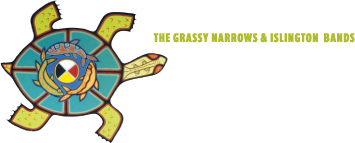Wabaseemoong Independent Nation
Wabaseemoong Independent First Nations had previously been known as the Islington Band or the Whitedog Reserve. It was made up of the communities of Whitedog, One Man Lake and Swan Lake.
Generally speaking, the residents of this area experienced a lifestyle similar to that of Grassy Narrows.
A severe disruption of life to both occurred in the 1950s. Ontario Hydro flooded lands traditionally occupied by members of these First Nations. Wild rice harvesting and trapping and other such activities were no longer possible in areas flooded.
Overall, the traditional lifestyle had already begun to change before the mercury poisoning of the English-Wabigoon River system in 1969 when the contamination first became known to area inhabitants.
Between 1920 and 1948, commercial fishing developed around the One Man Lake reserve. Hunting and fishing lodges encouraged tourists to visit the area. Pulpwood cutting provided an alternate source of income for some.
Also, in the 1950s harvesting of green wild rice and winter ice fishing became a source of livelihood.
This is just a brief overview of the situation affecting both First Nations. They experienced a much more severe disruption in their ways of making a living after the discovery of mercury contamination.
Commercial fishing was ruined. Hunting and fishing lodges were closed. For example, the Ball Lake Lodge used to employ almost all of the employable adults at Grassy Narrows, either on a full-time or a part-time basis. It was closed in the summer of 1970. The lodge was not re-opened until 1990.
The settlement that was made into law in 1986 provided funding for economic development for both First Nations. A detailed account is found in the Cosway Report.
The legislation of July 1986 set up institutions that were supposed to provide employment opportunities for First Nations members.
Various financial settlements with the Wabaseemoong Independent Nations came out of the agreements with the parties involved in the dispute. In addition to the money turned over to the First Nations corporation, promises included the construction of a high school as well as other community facilities.
The economic development initiatives agreed upon included ones similar to those of Grassy Narrows First Nation. Some were different, for example, greenhouse and seedling production, a commercial fishery, logging, to name a few.
As of 2009, the Wabaseemoong Independent Nations had 1,756 registered members. The 1996 census showed that 39% of those over 15 years of age had less than Grade 9 and 56% had Grade 9-13. There were few members with an education above Grade 13. The unemployment rate was 40%. The unemployment rate since 1978 was considerably reduced. It was 80% in that year.

Affected Communities

Mercury Disability Board
P.O. Box 621
Kenora, Ontario P9N 3X6
Phone: 807.466.3146
Fax: 1.833.324.2245